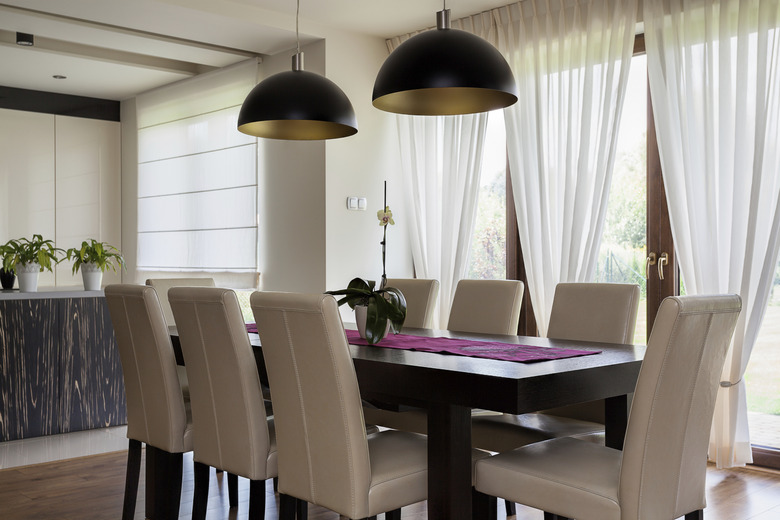The Height Of A Light Over A Dining Table
A chandelier or pendant light is like jewelry for your dining room, drawing the eye upwards and adding a level of elegance. However, as mismatched jewels can diminish the look of a fantastic outfit, so too can a poorly hung light detract from the overall impression of the room. A dining room fixture, whether it's a sparkling chandelier or a multi-light pendant, must hang low enough to illuminate the dining table but high enough that it doesn't block the sight lines of dinner guests. Using an average 8-foot ceiling as a guide, the general rule is that the bottom of the light fixture should land between 30 and 34 inches above the top of the dining table.
Rooms With High Ceilings
Rooms With High Ceilings
In instances where ceilings are higher than 8 feet, designers differ in opinions. Some believe that ceiling height has no bearing on the relative placement of the light fixture and that the distance between the fixture and the table should remain between 30 and 34 inches. Others support the notion of adding 3 inches to the chandelier height for every additional foot of ceiling height.
In a dining room with a 20-foot cathedral ceiling, that would mean a gap of at least 66 inches between the table and the bottom of the chandelier. That would appear very out of scale and imbalanced depending on the fixture, so view this rule as more of a guideline. At the end of the day, appearance is more important than following arbitrary design rules. You may need to order an additional length of chain along with your chandelier if you have high ceilings as more chain gives you more height adjustment options.
Scale and Proportion
Scale and Proportion
Ceiling height is not the only factor to consider when choosing a light fixture. The size and volume of the room matter, as do the dimensions of the furniture in the space. The dimensions of the dining table and chairs, as well as any accessory pieces, such as a sideboard or buffet, should appear in scale with the chandelier for a balanced, well-proportioned aesthetic.
Ideally, the diameter of the chandelier should be at least 12 inches narrower than the table's width. An alternate method of calculating the approximate diameter of the chandelier is to add the length of the room to the width of the room. If the room is 20 feet wide by 10 feet long, for example, the light should have a diameter of 30 inches.
Scale your fixtures for comfort, as well as aesthetics. For more narrow tables, consider the height of the people who most often use the dining room and the manner in which they use it when positioning the light. If the table is only 36 inches deep and one of the primary diners is 6 feet tall and will regularly lean over the table to serve and clear dishes, he will likely hit his head on the light quite regularly if it hangs only 30 inches above the table.
Wattage
Wattage
A light fixture must be as functional as it is attractive. For this consideration, the amount of light produced by the fixture is more important than its size. To determine the proper light strength, multiply the length and width of the room to arrive at its square footage. A 12-foot by 16-foot room comprises 192 square-feet of space. Each square foot of space requires 1.5 watts of illumination, so multiply the square footage by 1.5. A room that is 192 square-feet in size requires 288 watts. If you fear that this much light will work well as task lighting but interfere with the ambiance of the dining space, put the chandelier on a dimmer switch to create options. When buying LED bulbs that are labeled in lumens rather than watts, use 15 to 16 lumens per watt.
